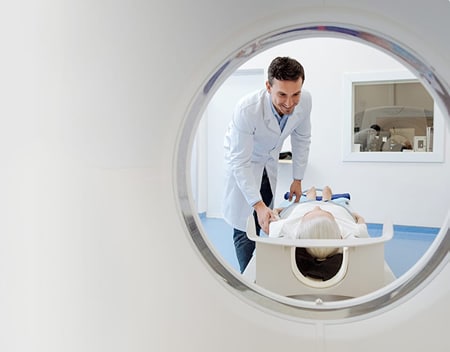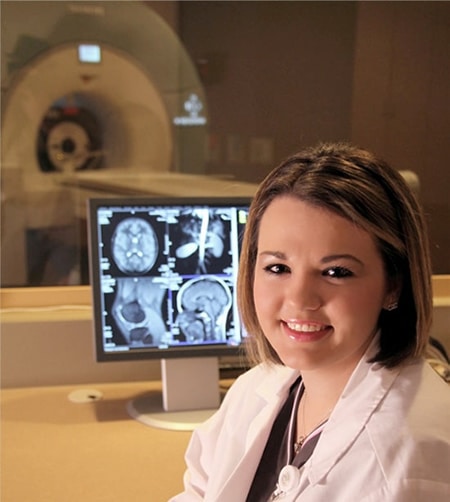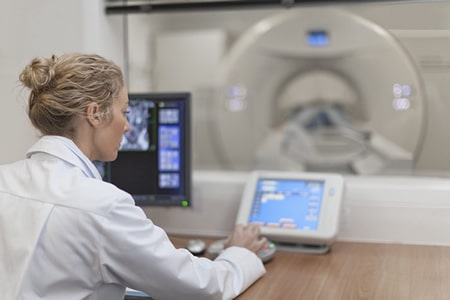What is a CT scan?
A CT scan, also known as a computed tomography scan or CAT scan, is a noninvasive diagnostic imaging procedure that uses a combination of X-rays and computer technology to produce horizontal, or axial, images of the body. These images are often referred to as slices and show details of any part of the body, including the bones, muscles, fat, and organs. Unlike a standard X-ray, CT scans show a more detailed view of internal organs and other internal structures.
How does a CAT scan work?

CT scans may or may not involve a contrast dye. Contrast refers to a substance that patients can take by mouth or by an intravenous line, IV, that causes the particular organ or tissue under study to be seen more clearly.
Patients can feel a flushing sensation, a salty or metallic taste in the mouth, a brief headache, or nausea and/or vomiting after injections. These effects should last only last for a few moments.
Why would I need a chest CT?
The chest contains organs of the respiratory and cardiovascular systems, as well as the esophagus. CT scans of the chest can provide more detailed information about organs and structures inside the chest than standard X-rays, thus providing more information related to injuries and/or diseases of the chest organs.
A CT scan of the chest may be performed to assess the chest and its organs for tumors and other lesions, injuries, intrathoracic bleeding, infections, unexplained chest pain, obstructions, or other conditions, particularly when another type of examination, such as X-rays or physical examination, is not conclusive. In addition, patients may need a chest CT after a diagnosis has been made to evaluate the effects of treatment of thoracic tumors or to provide guidance for biopsies and/or aspiration of tissue from the chest.
CT scans of the chest may also help to visualize the placement of needles during biopsies of thoracic organs or tumors or during aspiration (withdrawal) of fluid from the chest. CT scans of the chest are useful in monitoring tumors and other conditions of the chest before and after treatment.
Preparing for a CAT Scan
Before your scan, a member of our staff will explain how the imaging test will work and provide you with the opportunity to ask any questions that you might have. If your scan requires the use of contrast dye you will be provided consent forms to complete before the procedure. However, if you are allergic to iodine or have ever had a reaction to any contrast dye notify the technologist. In addition, notify our staff if you are pregnant or suspect that you may be pregnant before your scan.
Patients are not required to fast prior to the scan unless the contrast dye is being used. Additionally, the use of the contrast dye may require a patient to discontinue certain medication after the scan, such as metformin, for 48 hours. It is important to disclose any abdominal piercings or metallic objects such as a pacemaker as these items can interfere with the accuracy of a CT scan of the chest. Our staff will provide these and any other special instructions you may require before your scan.
What To Expect During Chest CT Scan

Patients will then lie on the scan table with their arms above their head. The scan table slides into a large, circular opening of the scanning machine. The technologist will be in another room with the scanner controls but visible through a window. Additionally, there are speakers inside the scanner so you can communicate with the technologist.
If there are problems at any point, including but not limited to breathing difficulties, sweating, numbness, or heart palpitations, use the call button in the machine to let the technologist know immediately.
Once you are in the proper position the scanner will begin to rotate around you. As x-rays will pass through the body for short amounts of time. During this time, you will hear clicking sounds, which are normal. The X-rays absorbed by the body’s tissues will be detected by the scanner and transmitted to the computer. The computer will transform the information into an image that the radiologist can interpret. It is important to remain still during the procedure and there are times that you will need to hold your breath. Our technologists will make sure that the procedure is as quick and as comfortable as possible. After the scans are complete the technician will remove the scan table from the machine and you can move about while the radiologist examines the scans.
What Our Patients Say
“Very thorough and professional the CAT scan tech Timothy went out of his way to help me on a Sunday and made sure I understood all prep instructions.” - Laurie B.
Recovery After CT Scan
Unless specifically stated by your doctor, there is no special type of aftercare instructions. Patients may leave the hospital after their scan and resume their usual diet and activities. If you notice any pain, redness, or swelling at the IV site after you return home, you should our office immediately as this could indicate an infection or another type of reaction.
If a contrast dye was used during the scan, patients may have to be monitored for a short period of time before leaving the hospital. This is to make sure there are no side effects to the dye. IV contrast dye side effects can commonly include itching, swelling, rash, or difficulty breathing. If you receive the contrast dye by mouth, you may experience diarrhea or constipation.
What are the risks of getting a CT scan?

Patients that are receiving contrast are at a risk for having an allergic reaction. If you have ever had a reaction or have any kidney problems let our staff know before the exam. In some cases, the contrast dye can cause kidney failure, especially if the patient has underlying kidney problems or is dehydrated. Patients taking the diabetes medication metformin, or its derivatives, with contrast are at risk for developing a condition called metabolic acidosis, an unsafe change in blood pH. A reported seafood allergy is not considered to be a contraindication for iodinated contrast. There may be other risks depending on your specific medical condition. Be sure to discuss any concerns with your doctor prior to the procedure.
Alternative Diagnostic Procedures
For problems of the lungs and the respiratory tract, our staff may recommend one of these other related diagnostic imaging tests in addition to a CAT scan. These procedures include
- Bronchoscopy
- Bronchography
- Chest fluoroscopy
- X-ray of the chest
- Chest ultrasound
- Lung biopsy
- Lung scan
- Mediastinoscopy
- Oximetry
- Peak flow measurement
- Positron emission tomography (PET) scan
- Pleural biopsy
- Pulmonary angiogram
- Pulmonary function tests
- Sinus X-ray
- Thoracentesis
Schedule A Consultation
To learn more or schedule a CT scan call 928.532.1150. Summit Healthcare serves Show Low, Snowflake, Pinetop-Lakeside, and surrounding areas in Arizona.
Online Resources
The content Summit Healthcare provides here is for informational purposes only and was not designed to diagnose or treat a health problem or disease, or replace the professional medical advice you receive from your doctor. Please consult your healthcare provider with any questions or concerns you may have regarding your condition.
This page contains links to other websites with information about this procedure and related health conditions. We hope you find these sites helpful, but please remember we do not control or endorse the information presented on these websites. Similarly, these sites do not endorse the information contained here.


